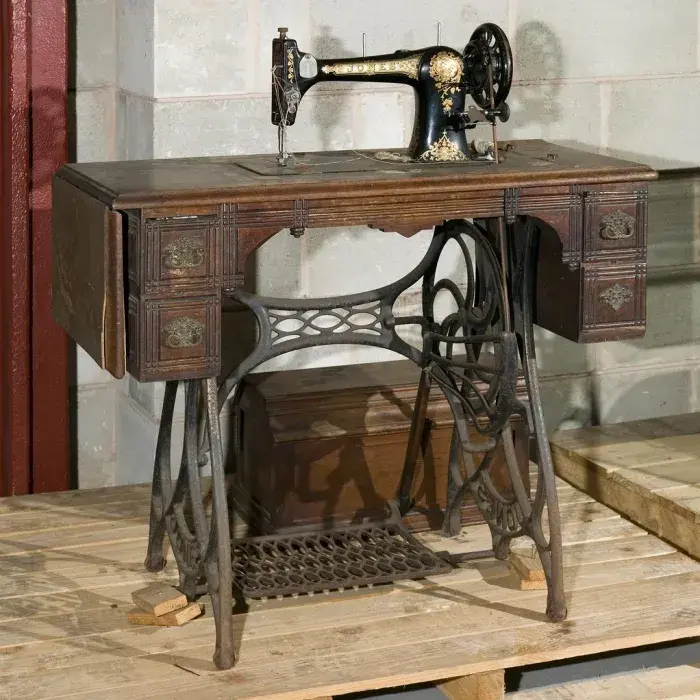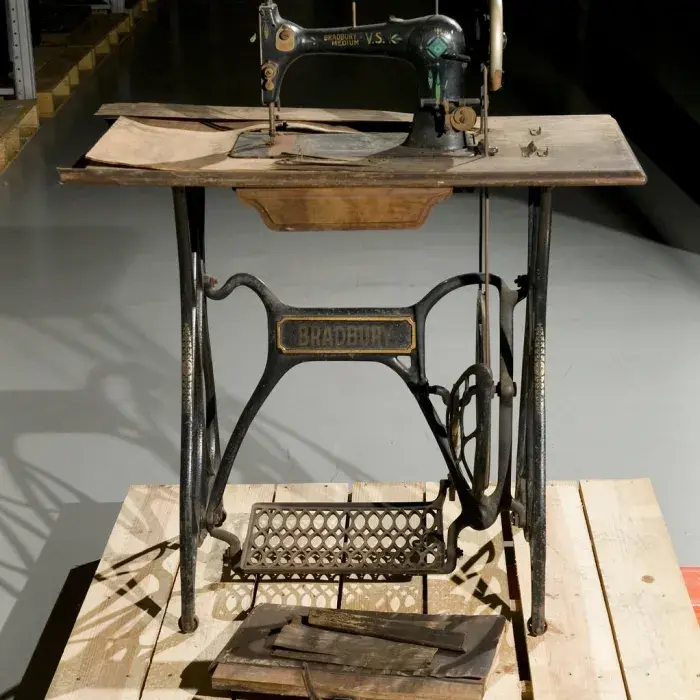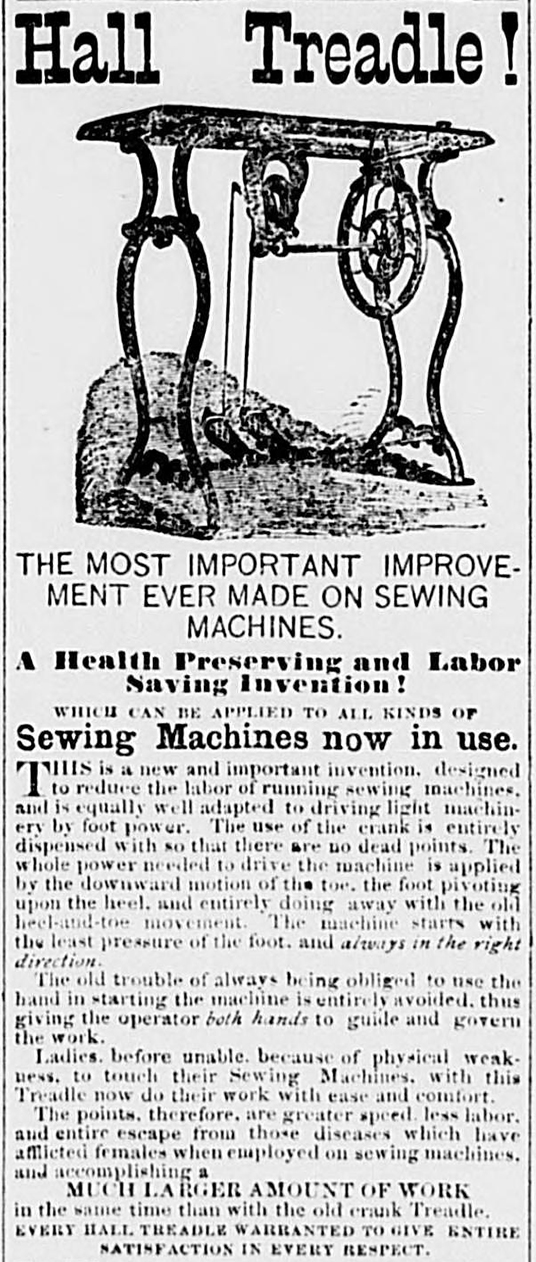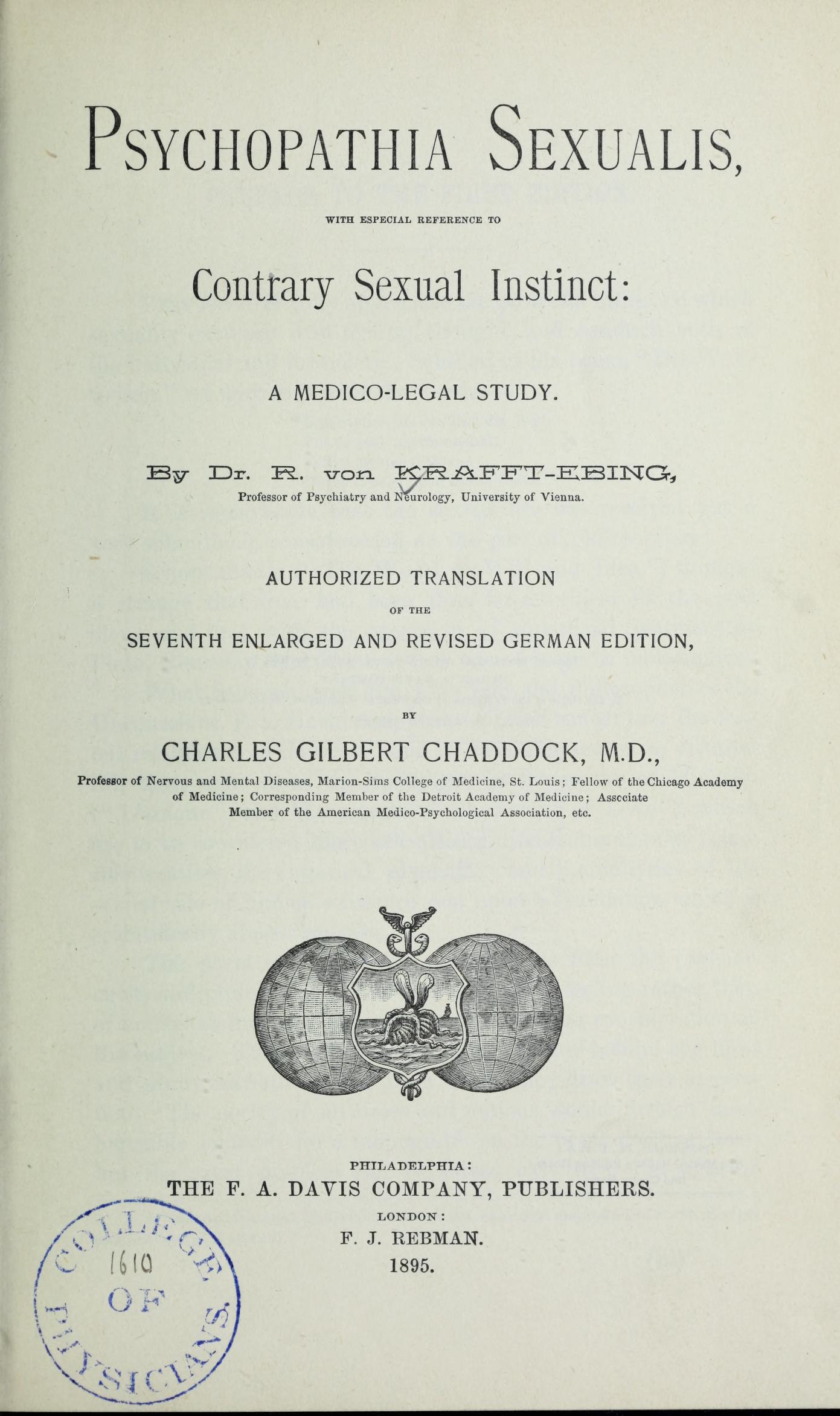This post contains potentially distressing discussion of historical medical attitudes to and treatments of women’s bodies. It uses offensive medical terms in quotation from historical sources.
When preparing for our February LGBTQ+ history talk ‘That which never can be suppressed’, I happened across a rather surprising assertion about the dangers of sewing:
this vice [lesbian love] is, of late, quite the fashion, – partly owing to novels on the subject, and partly as a result of excessive work on sewing-machines …
Notwithstanding the many 19th-century interpretations of sexuality and sexual behaviour that are strange to modern eyes, my mind frankly boggled at what the possible link between sewing machines and sexual attraction between women could be, and so I simply had to dig further into the topic.
The quotation comes from the 1895 English translation of the 7th edition of Richard von Krafft Ebing’s Psychopathia Sexualis, a significant work about sexual psychology. At first I wondered if there was a translation error at work, as this was an English translation of a German text. The German version, published in 1892, says:
… diese Verirrung [amor lesbicus] neuerlich sehr in der „Mode“ ist — zum Theil durch bezügliche Romane, zum Theil durch Erregung der Genitalien in Folge excessiver Arbeit an der Nähmaschine …
The English translation of this section is mostly a very faithful rendering of the original, but there is one difference, possibly made deliberately to obscure the most explicit part of the description. (The translation of text from German to English, making it accessible to a wider audience, was unfavourably commented upon when the book was first published.) The original German includes that the use of sewing machines is causing ‘Erregung der Genitalen’, excitement of the genitalia, but this wasn’t included in the published English version. A full English translation would therefore say:
this vice [Lesbian love] is, of late, quite the fashion,---partly owing to novels on the subject, and partly through the excitement of the genitalia as a result of excessive work on sewing-machines …
The book’s author, Krafft-Ebing, stated that he’d learned about this effect from the work of another author, A. Coffignon, in his 1888 book La corruption à Paris. Coffignon, however, didn’t actually state the matter in quite the same strident terms and didn’t make the direct link with sexuality.
His text could be translated as:
Amongst workers, the irritation resulting from overly lengthy seated work causes agitations of the hips, the disastrous effects of which are well known by doctors, comparable to those caused by the horse on many female horse riders. Shall I speak also of the negative physiological consequences of the sewing machine?
Coffignon didn’t explicitly link the motions of the sewing machine with lesbianism, rather hinting darkly at ‘disastrous effects’ and ‘negative physiological consequences’. He was clearly referring to something that was, to some extent, common if unspoken knowledge in some quarters: the supposed dangers of the movements inherent in operating a sewing machine.
The sewing machine
The sewing machines in question were not the electric-powered table-top variety we’re familiar with today. These were treadle-powered machines used in industrial clothing manufacture. Various models had been developed since the invention of the first reliable sewing machine around the middle of the 19th century, but they were all generally powered with a foot treadle located beneath a table-mounted machine.


These illustrations show single-treadled varieties, but early machines were operated with two pedals, one for each foot, which moved up and down in opposition to each other.
The invention of the sewing machine and its widespread adoption within the textiles industry was not without controversy. The machine was revolutionary in the speed it brought to what had previously been a painstaking job to undertake by hand, but the workers didn’t reap the benefits of the technological advances. Though the sewing machine had speeded up the sewing process, it had – if anything – made it more, and not less, physically demanding, with seamstresses working maybe 10 or 12 hours a day treadling their machines.
Health and safety at work
As someone who once saw a school classmate injure herself quite spectacularly with the needle-end of a sewing machine (details omitted to spare the squeamish), I’m no stranger to the idea that sewing machines are dangerous. However, people of the 1860s were less concerned about the high-speed needles as the overall physical effort and exertion required by the early machines.
Already by 1860, doctors and others were raising concerns about the effects of sewing machine usage, reporting that they could damage eyesight, cause exhaustion, damage the female reproductive system, and cause uterine prolapses and miscarriages.
But this was not a universal view. The American professor of midwifery A.K. Gardner presented a paper to the US Academy of Medicine in 1860, published in the American Medical Times, in which he spoke up strongly in favour of the sewing machine as ‘a blessing to mankind, and especially to the female, and that without an appreciable drawback’. He said that he’d found no evidence of physical harm to machine operators, and that the ability to work outside the home in light and well-ventilated workshops (which he apparently assumed them all to be) is of mental benefit and that the physical activity of driving the sewing machine improves the physical condition of the muscles and organs. However, that he felt the need explicitly to state that ‘I have never seen a single patient who gained her living by working a sewing-machine, who was affected with leucorrhcea [pathological vaginal discharge], “falling of the womb,” “ulcerations of the womb,” or spinal difficulty’ indicates that these were allegations against the machine that had currency at the time.
Later in the decade, French physician Eugène Guibout presented a different view to the medical society of the hospitals of Paris in April 1866. His view was echoed by Physician John Langdon Haydon Langdon-Down (1828–1896), in the British Medical Journal for January 1867.
Both men reported alarming lists of symptoms. In Guibout’s report, weight-loss, weakness, stomach complaints, disrupted periods, ‘white discharge’ (ie leucorrhoea) and ‘genital excitement’ predominate. In Langdon-Down’s account, we see palpitations, pain in the back and thighs, dilated and unreactive pupils, supraorbital headache, giddiness, ‘cobwebs’ in front of the eyes, ‘great debility’ and lethargy, and, again, ‘leucorrhoea’.
Langdon-Down was the resident physician and superintendent at Earlswood Asylum, an institution for psychiatric patients in Surrey. He thought that the effects he attributed to sewing machine use were very similar to those he had seen in patients at the asylum in connection with ‘habits of masturbation’. He therefore concluded that the symptoms in machinists were due to ‘immoral practices’ induced by the ‘erethism’ or rubbing of the external genitalia caused by the action of operating the machine. He observed that patients improved when they gave up the habit (either of using the sewing machines or of masturbating), and took plenty of fresh air, proper exercise, and calming medications. In Guibout’s version, the women themselves are reported to admit that some workers were experiencing sexual excitement, resorting to leaving the workshop and dousing themselves in cold water to relieve the sensations.
Perhaps the most lurid description of the perceived problems comes from the writings of another French physician, Thésée Pouillet (1849–1923), in his study of female masturbation, Etude médico-philosophique sur les formes, les causes, les signes, les conseq́uences et le traitement de l'onanisme chez la femme. In the early editions he noted that the agitations causes by the motion to-and-fro of the pedals causes the inner and outer labia to rub together, and that the resulting ‘heat’ led to masturbation and accompanying near constant vaginal discharge. In the third edition of 1880, he painted a much more lurid picture of what was (supposedly) happening to female machinists:
“During a visit I made one day to a factory of military clothing, here is the scene which I witnessed. In the midst of the uniform noise of about thirty sewing machines, I suddenly heard one of these devices working with more speed than the others; I looked at the person who set it in motion, it was a brunette of 18 to 20 years old. As she automatically pushed the trousers she was making onto the shelf of the machine, her face came to life, her mouth opened halfway, her nostrils dilated, the comings and goings of her feet drove the pedals in an ever-increasing motion. Soon I saw her eyes convulse, her eyelids drop, her head turn pale and fall back, her hands and legs stop and relax; a little muffled cry, followed by a long sigh, was lost in the noise of the workshop. The young girl remained swooning for a few seconds, pulled out her handkerchief, wiped her temples where the sweat was beading, cast a timid, ashamed, still slightly bewildered look at her companions and went back to work. With my guide, who had noticed my attention, I approached the machine operator, who was blushing, lowered her head and stammered a few words before her boss had even said a word to ask her to sit down fully and not on the edge of the seat. As I was leaving, I heard again, but from another part of the room, a machine accelerating its movement. My companion began to smile and told me that this was so frequent that they hardly paid any attention to it. This phenomenon, according to him, is found especially in young mechanics, in apprentices and in those who only sit on the edge of their seat, which singularly facilitates the rubbing movements of the genital lips on top of each other.”
This description reads far more like an imagined fantasy than a medical report, and it’s hard to take its claims seriously. It’s easy to imagine that the conditions endured by industrial textile workers would have caused physical and mental damage, but were women really regularly experiencing orgasm at their work benches?
Solutions to the sewing machine 'problem'
Several writers noted that it was the treadling in particular that caused the damaging movements: both Guibout and Langdon-Down observed that those working on heavy machines operated by two legs treadling in opposite directions experienced the worst symptoms absent from those working light machines treadled with both feet together. In a series of lectures on public health reported in the British Medical Journal, physician Dr Edward Mapother (1881–1940) specifically recommended treadles made by Hall and Parson for ‘lessening the labour’ involved in operating the machines. Hall advertised their treadles like this in 1872:
‘Ladies, before unable, because of physical weakness, to touch their Sewing Machines, with this Treadle now do their work with ease and comfort. The points, therefore, are greater speed, less labour, and entire escape from those diseases which have afflicted females when employed on sewing machines’

Though the dangers of sewing machines were sometimes mentioned in books on ‘hygiene’ and female health throughout the rest of the 19th century, concerns about their use seem to have petered out. The need to power the machines by foot was replaced by using electrical power, and other technological developments caught public attention as greater dangers. Indeed, some writers identified a new concern and a risk to women’s morals. By 1897, Pouillet points to a danger he describes as ‘one hundred times worse’ that the sewing machine: the bicycle. (A view echoed to a certain extent by sexologist Henry Havelock Ellis.)
Further concerns about masturbation
Langdon Down asserted that masturbation could cause a range of symptoms in women who ‘indulged’ in what was at that time most definitely seen as a vice, but the surgeon Isaac Baker Brown (1812–1873) went much further in identifying the dangers of the practice, and in implementing a disturbing supposed cure.
Brown interpreted contemporary medical theories to mean that irritation or damage to peripheral nerves could affect the central nervous system, and in particularly concluded that ‘peripheral excitement of the pudic nerve’ (also called the pudendal nerve, the nerve that supplies the clitoris and other parts of the pelvic region) would lead to serious neurological and psychological illness. He identified eight stages of disease that would stem from prolonged ‘irritation’ caused by masturbation:
1. hysteria including disturbance to digestion and menstrual irregularities
2. spinal irritation leading to ‘uterine displacements’, damage to vision and paralysis
3. epileptic seizures, or ‘hysterical epilepsy’
4. catalepsy
5. epilepsy
6. 'idiotcy'
7. mania
8. death
Brown tested his hypothesis through surgery to remove the clitoris and labia minora of numerous patients[1] as reported in stark and graphic terms in his 1866 book, On the curability of certain forms of insanity, epilepsy, catalepsy, and hysteria in females:
‘I at once subjected this deduction to a surgical test, by removing the case of excitement. I have repeated the operation again and again, and it is the object of this book to show the results.’
After a brief introduction to his theory and surgical practice, Brown’s book presented 48 case studies of women affected by mental illness and/or neurological disorders. In almost every case Brown noted ‘usual operation performed’, ‘operation as usual’, ‘I performed my usual operation’, simple words which only add to the horror of the surgical mutilation being performed. Unsurprisingly, the case studies in routinely record that after surgery patients made a good recovery, enjoyed happy marriages and bore healthy children, without relapses of their previous symptoms. However, a review of the book in the British Medical Journal noted that these apparent cures only stuck if the patients with ‘careful watching and moral training’, which suggested that the surgical intervention wasn’t necessarily the decisive factor.
Brown undertook his work at the London Surgical Home for the Reception of Gentlewomen and Females of Respectability suffering from Curable Surgical Diseases in Notting Hill, London. The annual reports of the home record that women were treated there for various gynaecological conditions including fistula, uterine prolapse and tumours as well as for the conditions – 'hysteria', 'hysterical mania' 'epileptic fits' 'cataleptic fits' – for which he was undertaking routing clitoridectomies.
This practice, however, would shortly bring about Brown’s downfall. His book and other advertising for the home – particularly through the Church Times newspaper – brought him to the attention of the medical press, the Obstetrical Society of London and the Commissioners in Lunacy, the official body that oversaw the treatment of mentally ill people at the time.
Over the course of several months in late 1866 and early 1867, Brown was criticised for a number of things: he was said to be operating without proper consent from his women patients or their husbands; he was claiming to treat ‘insane’ patients in an institution not licensed to do so, and he offended professional norms by not undertaking proper consultation and agreement with his patients’ personal or family physician.
The situation culminated with the Obstetrical Society of London tabling a motion to eject Brown from the Society. This was discussed vociferously by members at a meeting on 6 March 1867, and again on 3 April 1867, when the society met to vote on the resolution. Brown was expelled by 194 votes to 38, with 5 abstentions. After this disgrace Brown quickly fell into obscurity.
So what’s this got to do with lesbians?
Brown was brought down not for the simple fact that he was treating a spurious diagnosis of female ‘hysteria’ with medically and ethically inappropriate mutilation of women’s bodies. The medical arguments of the time were undecided on whether clitoridectomy was a potentially appropriate treatment or not. It was Brown’s hubris in advertising his Surgical Home and its supposed cures, his lack of transparency when questioned about his activities, and the fact that he was operating on women without their consent or (perhaps more importantly) the consent of their husbands or families that lead to his expulsion from his professional society and his fall from grace.
Both the sewing machine panic and Brown’s (thankfully short-lived) penchant for removing clitorises are expressions of wider concerns about women’s bodies in 19th century Europe. I haven’t yet found a contemporary text that explicitly lays out the 19th-century reasoning for linking the supposed masturbatory effects of the treadle-operated sewing machine with lesbian attraction. We can suppose that the thinking must have been that if women start inadvertently experiencing sexual excitement without the involvement of a man while sat at their machines, they might not only start seeking it themselves through masturbation, but also through sexual activity with other women. That was, of course, seen as a threat to male power over women.
Katie Birkwood, rare books and special collections librarian
[1] A practice similar to types of female genital mutilation which are still carried out (illegally in the UK) today.
Sources used in this post
- Baker Brown I. On the curability of certain forms of insanity, epilepsy, catalepsy, and hysteria in females. London : Robert Hardwicke, 1866. https://archive.org/details/b21783160/page/n13/mode/2up [Accessed 1 July 2022].
- British Medical Journal. Editorial articles and news reports throughout 1866 and 1867.
- British Medical Journal. Review of I Baker Brown, On the curability of certain forms of insanity, epilepsy, catalepsy, and hysteria in females. BMJ. 28 April 1866;278:438–440.
- British Medical Journal. The Obstetrical Society: meeting to consider the proposition of the Council for the removal of Mr IB Brown. BMJ. 6 April 1867;327:395–410.
- British Medical Journal. Report of Dr Mapother’s lectures on public health in Dublin. BMJ. 26 April 1873;643:470.
- Darby R. The Benefits of Psychological Surgery: John Scoffern's Satire on Isaac Baker Brown. Med Hist. 2007;51:527–544. https://doi.org/10.1017%2Fs0025727300001794 [Accessed 1 July 2022].
- Kandela, A. Sketches from The Lancet: Clitoridectomy. The Lancet. 1999;353:1453.
- London Surgical Home for the Reception of Gentlewomen and Females of Respectability Suffering from Curable Surgical Diseases. Proceedings at the Seventh Annual Meeting. London: Savill & Edwards, 1865. https://archive.org/details/b30566885/mode/2up [Accessed 30 June 2022].
- Offen K. ‘Powered by a woman's foot’: A documentary introduction to the sexual politics of the sewing machine in nineteenth-century France. Women's Studies International Forum. 1988;11:93–101.
- Royal College of Surgeons of England. ‘Brown, Isaac Baker (1812 - 1873)’ in Plarr’s lives of the fellows. https://livesonline.rcseng.ac.uk/client/en_GB/lives/search/results?qu=%22RCS: E000986%22&rt=false|||IDENTIFIER|||Resource+Identifier [Accessed 14 July 2022]
- Scientific American. The Effect of Sewing Machines upon Female Health. Scientific American. 12 June 1869;20:378. https://babel.hathitrust.org/cgi/pt?id=pst.000062999229&view=1up&seq=386&skin=2021 [Accessed 13 July 2022]
- Scull A, Favreau D. The Clitoridectomy Craze. Social Research. 1986;53:243–260.

